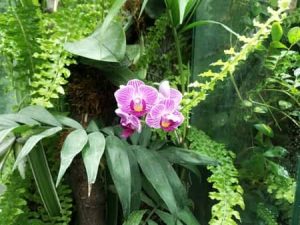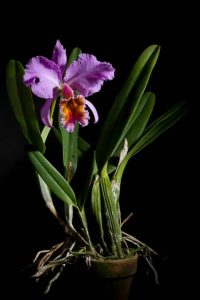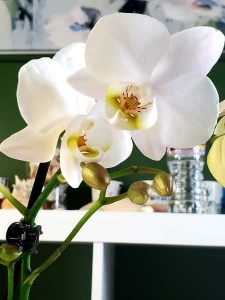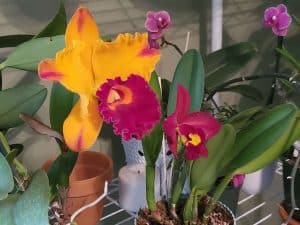rchid environmental adaptations are inspiring and ingenious. Originally from the swamps and savanna grasslands, orchid seeds traveled through the air and nestled into the nicks and crannies of trees of hardier, nearby rainforest forests. To survive so far above the ground and without soil, orchids had to adapt.
Orchids adapted by transforming their roots, leaves, seeds, and pollination methods to better grow. These adaptations allowed orchids to capture, process, and store nutrients. Orchid roots adapted to maximize absorption of humidity, minerals, and micronutrients. Orchid leaves absorb condensation droplets falling from above them, rich with airborne debris and compost. Their stems and seeds altered due to the environment, providing a new way to survive.

More than 70% of all orchids are epiphytes, which means they grow on trees or rocks.
Only 30% are terrestrial orchids, which grow in soil. With over 30,000 species called epiphytes, they nestle on top of other plants, climbing up the tree bark. Some epiphytes absorb their nutrients until the underlying plant dies since they don’t have a way to capture and process their own food, but they are not parasitic or harm their “tree” host in any way.
Epi – on top
Phyte – plant
Most of the 83 families of epiphytes plants are parasitic. Orchids, on the other hand, are not. Just because they attach themselves to tree bark doesn’t mean they are interfering with the tree’s life cycle. They just need a secure, immovable base to feel safe.You’re in luck!
There’s a video about this exact content so you don’t have to read all 3,000 words below. 🙂 https://www.youtube.com/embed/l8yhom40UV8
How does an orchid survive?
Orchids have environmentally adapted to their climates and surrounding, yet that doesn’t mean your orchid will adapt well to any condition that you provide for it.
It just means that you have to research more where your particular orchid thrives and recreate that specific environment for it. Orchids survived because they made the best out of each opportunity: leaves, stems, roots, seeds, and flowers.
- Domain – Plant
- Kingdom – Anthophyta
- Phylum – Monocotyledonae
- Class – Asparagales
- Order – Orchidaceae
- Family – under debate (?)
- Genus – 763
- Species – 28,000 cataloged
Orchids Adapted Over Millions of Years
The environmental adaptations talked about in this article did not happen overnight but over millions of years. In fact, the first orchid pollinia (a pollen capsule) was found petrified in amber dating over 15-20 million years ago. It was researched, pointing to a now extinct orchid family called Cranichedae.
Not all botanist agree with that amber specimen being the oldest. Some hold that the first orchids, named the Meliordis caribea, are older. A fossilized orchid appeared dating back to in the late Cretaceous Era, around 76-89 million years ago.
Orchids started off as a single family and branched out, diversifying into almost 800 specific and distinct genera, which subdivided into 28,000 species (that we know of and are cataloged). These orchids have adapted to live in all the continents and habitats except areas covered in glaciers.
These adaptations have ecologically distributed orchids around the world, and now, orchids can be cultivated most anywhere.
70 genera grow in Oceania
26 grow in North America
250 genera grow in Tropical America
300 grow in Tropical Asia
60 grow in Europe and Temperate Asia
Some orchids have modified so much they have enormous species, like the Bulbophyllum orchids with over 2,000 species. The Epidendrum genus has 1,500 species, and Dendrobium has over 1,400 species.
Just because orchids have been highly adaptable, don’t expect your supermarket orchid to thrive in your overly dry indoor room if no additional care is given to it. Orchids took millions of years to adjust to it’s surroundings. You’ll need to research each orchid genus and species, since the diversity of orchids is so vast.
Research is essential.

Orchid Pseudobulbs Adapted to Their Climates
Adaptations made orchids survive well in almost all kinds of habitats, even dry ones. Desert orchids (like some rare species of Corallorhiza, Eulophia petersii, the steam orchid (Epipactis gigantea), Listera, and Platanthera) are not the first orchid that comes to mind when you hear ORCHID, and also not as likely to be searched out for commercial use.
To adapt in climates where water is scarce, these orchids have grown pseudobulbs, a energy, water, and nutrient storage bulb. Some orchids, like Catasetum, have gone dormant in the hot, drier months of the year, waiting to awake from dormancy when the climate is more humid. These dormancy cycles are so extreme, they lose all their leaves and look half dead.
This storage compartment can be compared to a camel’s hump, storing water whenever it can. This allows the orchid to survive in habitats that you normally wouldn’t think an orchid could grow.
Orchids have adapted to drying spells as well as extremely high humidity environments. Which such ability to fit in its climate, orchids have rapidly spread out to be diverse in genera and species.
Orchids are so diverse, they are grouped into elevation and temperature preferences. This is mainly due to how well they capture and store water, how much chlorophyll they have, and how much energy they can store. All these can be directly or indirectly related to having a pseudobulb and what the humidity and/or rainfall is like in their growing conditions. -x-x-x-x-
Cold Growers live above 2500 m in the mountains, and at night the temperatures during winter stay around 50 – 58 F (10 to 14 C).
Cool Growers survive in lesser altitudes from around 1800 to 2500 m, and prefer to go no lower than 58 – 66 F at night. (14 to 18 C)
Intermediate Growers can extend and overlap a few categories.
Warm Growers grow closer to sea level, starting to flood the plains and valleys at 1000 to 1800 m high. They also prefer warmer nights during the winter, no colder than 66 – 75F ( 18 to 23 C).
The hot growers are close to sea level, and thrive up to 1000 m in altitude. They do not tolerate cold nights, and will start to die if the temperature drop below 75 – 85 F (23 to 29 C).
-x-x-x-x-
The first thing to know is if your orchid endures drought well or if it prefers lots of constant watering. An orchid that endures drought is very closely related to the succulents and can be planted in floral designs with them. A good hint is the presence of a pseudobulb. Orchids that don’t have pseudobulbs will need more frequent watering, like Phalaenoposis.
Let’s take a look at the Cattleya orchid for an example.

Image Credit: “[Venezuela] Cattleya lueddemanniana ‘Paul Drago’ Rchb.f., Xenia Orchid. 1: 29 (1854)” by sunoochi is licensed under CC BY 2.0
They have differentiated stalks near the roots but not massive pseudobulbs, suggesting they can hold back from constant watering, moreso than a Phalaenopsis can.
Since these pseudobulbs stores nutrients and water for drought spells, they need to dry out before the next watering, maximizing their storage.
The thicker the pseudobulb, the more water deficiency the orchid can withstand. In this case, the Cattleya can’t go too long with out water.
Drought-seeking orchids have thicker leaves, also used for water storage. A coating of wax covers the surface of the leaf, also preventing the loss of moisture and gas exchange in drier or hotter weather.
NOTE: The humid-thriving orchids do NOT withstand dry spells at all. If these orchids are withheld from a source of water, they will die. Orchids adapted to live in the climate they were at over thousands of years, but aren’t adaptable to dehydration due to lack of care.
To survive these dry desert like conditions, orchids adapted to going into energy-saving procedures when dry season comes around. Another adaption (other than the pseudobulbs) are that orchids shed their leaves and go into a long dormant period.
A perfect example of this is the Catasetum orchids.
They survive the long, dry spells due to their thick pseudobulbs, which keep them alive without water for months at a time. If your orchid doesn’t have a pseudobulb, it will want to be watered every day…but it’s main secret is the shedding of every leaf and the slow dying of the roots.
A few Dendrobiums are in this category, too.
If you have a water loving orchid and your home environment simulates a desert (usually due to air conditioning and ventral heating unit), this article about dry climates can provide some insights about how to raise the humidity levels for desert-like conditions.
Orchid Roots Adapted to Cling to Trees
The second adaptation (not in any particular order) was that orchids had to make a way to cling to the tree. For this, the orchid produced a very thin-celled layer of coating for the roots and modified it’s roots to become aerial.
This dead layer of coating is called velamen.
Orchid roots are actually very tiny, thread-like structures which are central conductive filaments. Believe it or not, without the velamen coating, they’re thinner than other houseplant roots.
With the extra layer of velamen, their surface area to capture nutrients more than tripled or quadrupled.
The thin sponge-like velamen adapted serves two purposes: (1) to trap humidity inside of the space between the velamen and the roots, and (2) to attach and anchor the orchid to the tree bark.
Velamen projects little white hairs, like a which cling to the sides of the tree (in our case, a pot.)

Root Adaptations to Transform Nutrients
The third adaptation on the root system was that they produce chlorophyll, too. Normally when we think of gas exchange and energy production we focus mainly on leaves. But orchids have doubled up on absorbing light in their roots as well. They can photosynthesize the light and transform that into energy.
Orchid roots also produce ways to process sunlight and transform it into energy. Even though they’re ⅓ of the height of the tree, a significant amount of leaves linger above them, filtering out most the light.
From those single plants 100 million years ago, orchids have adapted into multi-colored, multi-floral, and multi-scented blossoms that require vastly different growing conditions. From full sun to full shade and everything in between (dappled shade, partial shade, bright light or full light) orchids have modified their anatomical structure to better survive in each habitat.
Low-light orchids require 1200-2000 foot candles (fc)
Medium-light orchids prefer 2000-3000 fc
High-light orchids thrive with 3000 fc.
Phalaenopsis orchids, the most common supermarket orchid, is used to getting abundant light but not any of it is direct sunbeams. Most Phalaenopsis orchids love a window sill with a transparent curtain. They will burn if you place them in the direct afternoon sun with no protection.
Wisely, the orchid felt the need to adapt, processing the maximum sun it received, so it made the velamen with chlorophyll. This is the main explanation as to why the roots turn green when you water them. They are normally silvery-white colored, similar to powdery chalk with a mist of gray. When they are wet or humid, they turn into a vibrant green color. What you are seeing is just the chlorophyll being exposed to humidity, another adaptation created to survive.
Not all the orchid roots are happily buried under the potting medium for this reason. Your orchid will send out projections, which are called aerial roots. Here is an article all about aerial roots, so I won’t repeat it. But the main thing you need to know is that the aerial roots adapted to their environment, designed to capture more nutrients that float through the air.
Roots Adapted to Provide Gas Exchange
The velamen also adapted environmentally to serve a another purpose: respiration. The velamen in the roots is so thin (just a few cells thick) that it promote gas exchange. When a dry spell comes along, the velamen hardens, closing the exits through which water can leave. This also prevents gas from leaving the roots, too.
Most people think that it is overwatering that kills an orchid. This is true, but it’s not the water in itself. Over-watering just sets off the time-bomb. Being dead tissue, velamen can’t sense when it has had enough water. All it does is absorb. Being drenched in water, the gas can’t escape.
Water still is on the outside so the velamen remains drenched until the orchid dries out completely. The gas inside (oxygen, nitrogen, and carbon dioxide) the closed area builds up, forming carbonic acid. Here is another article that explains this process in more detail. To sum it up, the pH of the orchid goes skyrocketing, and the acid destroys the velamen and the roots.
Overwatering is what sets this process in motion. But what really kills the orchid is the gas buildup inside the velamen, which can’t escape. The toxins destroy the orchid from the inside out. These toxins are perfect for bacterial and fungal parties, too.
Air is fundamental for root growth.

Image Credit: © 2020 Orchideria.
All Rights Reserved.
Aerial roots are a way that the orchid has adapted to capture more airflow, which is abundant in the tropical and subtropical rainforest.
Providing a fan that is constantly running on a low setting will not only promote proper gas exchange but will also inhibit the production of mold and fungus from any water that happens to be sitting in the crown of the orchid.
Air circulation that is too high will do damage and make the orchid “insecure”, possibly breaking off the tender roots.
When we describe orchids as having human emotions, it’s not that we believe they do (of course…), but it’s a way to relate how the orchid structure reacts to its environment.
It’s the best way I’ve found to teach about orchids. Anyway…Keep the fan on low.
Orchid Seeds Adapted to Travel in Wind
Living in their new home in the heights, orchids needed to find a way to keep their seeds afloat. If they continued to produce heavy seeds, they’d drop to the forest floor, where nutrients and sunlight are rare. Knowing that was a certain death-sentence, orchids adapted to have their seeds come in the tiniest possible manner—so tiny they are measured in microns (µ).
To be successful, the orchid releases tens of thousands of seeds, hoping one makes it. Orchid seeds also adapted into a hot air balloon-like structure, which keeps them in the air long enough so they can find a new home. They can do this because they have no endosperm as normal seeds do.
Orchid seeds have no food storage and require a fungus called Mycorrhiza to provide it’s energy until the orchid can grow roots and leaves. This symbiotic relationship is another adaption so the orchid seed could travel higher and further distances to survive. The higher up on the tree trunks, the more access to sunlight and nutrients they have.
These little wind-surfers can travel great distances with this adaptation. For example, The same orchid families have been found in South America, the southern tip of Africa and Asia. This wouldn’t be possible if the orchid seed weighed ore than it does.
That does explain why propagating orchids from seeds is extremely difficult. Even nature has a high fail rate.
Don’t Stop Learning!
If you want to be included in more information and get a 14-page fertilization guide, please sign up for my newsletter. I don’t spam, but send emails out bi-monthly with some curious topics of interest. If you want more information, click here to go to a specific page on this website where I explain it more in detail.

Also, if you are looking for an orchid journal to keep your notes specifically about orchid care, check out my 2 solutions for that on this page. If note-keeping isn’t your thing, then there is a free excel spreadsheet that you can download. Click here for more information on how to do that.
If you subscribe to my newsletter, I will send you a 14-page guide on the main tips of orchid fertilizer. It is downloadable and you can print it out on your computer. I designed the guide to double up as a coloring book, just to make it fun.
Orchid Leaves Adapted to Trap in Humidity When Dry
Orchids made sure they could withstand the longer drought periods by adapting their leaves to close off any exits that humidity could escape. To provide proper gas exchange, the leaves have microscopic pores called stomata. These pores open when it’s humid, usually during the night, to let the oxygen out of the plant and intake carbon dioxide.
When you breathe, you don’t only lose air components. Water droplets are lost, too. It is the same with a plant. When gas exchanges occur, humidity from inside the plant is lost. If it is extremely dry, the orchid will prefer to not exchange gas over keeping the little humidity it has. To keep humid, the leaf hairs on the stomata close making it impermeable.
This is both good and bad.
If the dry conditions are prolonged and humidity is not raised, the trapped gasses inside the orchid become toxic. That is why it is so important to check the humidity in your environment (bedroom, office, living room) before asking the orchid to survive there. You can read more about raising humidity levels in this article.
When the humidity levels drop even more, the leaves of the orchid will try to reduce their surface area—they adapted to curl up on themselves. This is to prevent even more humidity from exiting the plant.
A Word of Peace: Time to Reflect
You Are More Adaptable Than You Think
The orchid made the maximum out of every opportunity it had—everything had to change. Leaves, roots, flowers, seed, and stem.
When we are in a situation that we don’t endure well, our first tendency is to complain. We sit in our pity-party of one person and muster away. This negative process contaminates our ability to think up positive solutions to adapt ourselves as to our new climate.
On a personal note, When I moved back to Kansas after more than 30 years in Brazil and another good portion in other countries, I had a hard time (that’s putting it mildly) adapting to the culture and the cold, freezing weather. The long, dark months without sun made me want to scream. In Brazil, I’d always be riding my bike or hiking up a waterfall to renew my strength. During winter in Kansas, I had no outlet.
I figured out quickly that either I could hate my situation and be miserable, or I could change.
My first instinct was to sit inside, bundled up on the couch under thick blankets. Some days I could hardly get out of bed. Seasonal depression is no joke. My solution: I could find ways to adapt to my situation.
The first idea was to find a winter sport to keep me active.
The second was to invest in indoor plants and turn my habitat into what I knew well. It’s so refreshing to see that hint of green in the grayish-white tones of winter.
The third way was to make goals, small ones, a goal I could reach every day.
At first, they were stupid, but to see that I could actually do something, and that I was capable of accomplishing small tasks, I set bigger ones. God hadn’t brought me back to my home just to watch me crumple up and die. If you want to know more about that, check our my memoir on the author page.
Adaptation, taught by the orchid, is how to survive and thrive in adverse situations. After all, 1 1/3 of the height, nestled in the groove of a tree, filtered sun from the overhead leaves…
After you’ve adapted well, sit back and enjoy the view from the tree-tops.
I hope that this article answered some of your questions about how orchids adapted and how they have survived 100 million years. If it has, please leave a comment in the box below, and check out some of our articles on how to build a great floral design or water your orchids. The LEARN page has a list of all our articles for more ideas.
If you still want to read some more about orchid adaptations, try this article in the Encyclopedia Britannica. It goes over the natural history of the orchid and how it survives today.
in the Encyclopedia Britannica. It goes over the natural history of the orchid and how it survives today.
Happy cultivating!


This article is a gem! The information you’ve provided is not only helpful but also presented in an engaging way.
Hi Richard,
Thank you! I appreciate it.
-Amanda